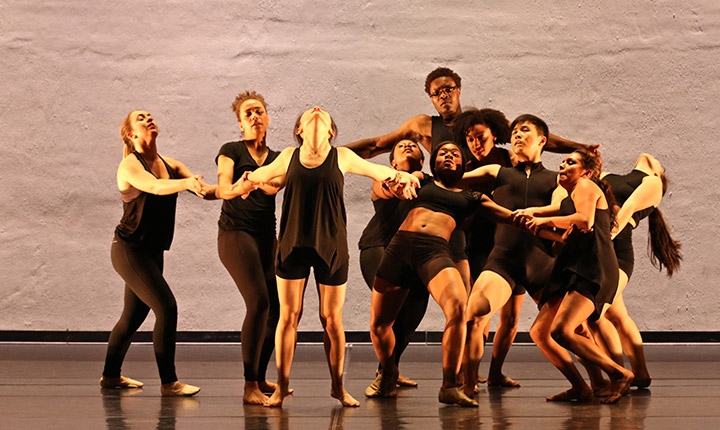Students are using a rich array of original artifacts in their studies at Bryn Mawr
 By Yi Gao
By Yi Gao
Learning with primary source materials is hot at Bryn Mawr College.
Working with authentic artifacts, rare books or archival documents fascinates students and generates interesting ideas. In recent years, the traditional, teach-centered classroom has become dynamic laboratory in which students can physically handle original materials.
Japanese prints, Quaker historical documents, pottery, sculpture and rare photographs are just a few of the items now available to students.
“Though professors have used primary sources in teaching for decades, it’s much more popular over the past four or five years,” said Marianne Weldon, collections manager of Bryn Mawr Special Collections. According to Weldon, special collections librarians have spent considerable time and energy improving the visibility and accessibility of the College’s collections and building collaborations with teaching faculty across multiple disciplines.

No. 2
This semester, Erin Schoneveld, Assistant Professor of East Asian Languages and Cultures at Haverford College taught her class Ukiyo-e: The Art of Japanese Print with Bryn Mawr’s collection of Japanese woodblock prints. Weldon assisted with her classes several times. Weldon said Professor Schoneveld thinks incorporating actual primary materials into teaching “fuels lively discussion and cultivates critical thinking.”
Bi-Co (Bryn Mawr College and Haverford College) faculty and students benefit from special collections of both colleges. Bryn Mawr’s special collections are more diverse and broad while Haverford is especially renowned for its Quaker collections and photograph collections.
Xingya Wang, a Bryn Mawr College senior student majoring French, said she took a war photography class at Haverford and had the opportunity to see some precious photographs of American Civil War.
“Their collection of war photographs is fantastic! Everyone was very excited! And it’s good that we (Bi-Co) share resources,” said Wang.
“Yes, I think our learning is more practical and interesting than when I was a freshman,” said Wang.
Many classes engage students with primary sources. On the other hand, students more actively use the college’s collections to do research. There are two important elements in the development of this trend.

No. 3
The first one is the digitization of special collections.
According to Eric Pumroy, Seymour Adelman Head of Special Collections at Bryn Mawr College, big libraries and institutions have been digitized their collections since the late 1980s.
Bryn Mawr College’s Special Collections, since it is a small institution with less funds, started establishing digital records of collections in the late 1990s. However, not until 2008 did Bryn Mawr begin making special collections accessible on the Internet to the public.
“It was a complicated work,” said Pumroy. First, Special Collections bought the collections management software called Embark. Second, librarians migrated the existing data to the new system. Then they cataloged the rest of the collections. Besides, collaborating with Swarthmore College and Haverford College, they established TriArte, a special database of 33,500 art and artifacts from Tri-Co.
For digitizing art and artifacts, librarians should not only enter information but also upload high-quality images. Pumroy said for some “special” three-dimensional objects, they need to produce 360-degree pictures.

No. 4
Pumroy said several digitization projects are still going on but 90 percent of the work has been done. Undoubtedly, the acceleration of mass digitization highly improves the availability and visibility of special collections. Faculty and students can search online, find the artifacts needed, send a request and get the objects to analyze in person.
Bryn Mawr College’s encouragement of experiential learning is the other major element. This change can be seen within the History of Art Department.
“I am happy to see that more art history professors incorporate practical learning” said Poppy Pu, a senior student majoring in art history. She said that when she was a freshman, she really wanted to take art history classes at University of Pennsylvania since some of them are taught in Penn Museum. “Though at that time in some classes we could saw authentic objects, we were rarely asked to do an independent research on the objects or to produce an exhibition” said Pu.

No. 5
Things changed over the past three years. In Fall 2015, Bryn Mawr announced a new Museum Studies Program which allows students to gain practical hands-on experience in Bryn Mawr Special Collections or even in museums in Philadelphia. Courses such as The Curator in the Museum and Contemporary Art in Exhibition provide students a full experience with primary sources. Thanks to the pilot program, every semester Bryn Mawr has several student-curated exhibitions on view in the Rare Book Room of Special Collections.
Pu said many upper-class art history major students use special collections to do their own research that is part of their theses. “It is amazing! Working with primary sources helps our studies a lot and makes them much more interesting,” she said. “I am a bit jealous of the freshmen. They can get this experience in their first year.”
Guide: All items are from the Bryn Mawr collections.
Item 1. Color woodblock by Katsushika Hokusai. Title: The Great Wave, from the series 36 views of Mount Fuji.
Item 2. Artist: Utagawa Kunisasa (1786-1864) Title: View of Hodogoya, from the series 53 Stations of the Tokaido Road, ca. 1838.
Item 3. Polychrome Glass Aryballos (Oil Flask), Greece/East Mediterranean, 6th Century BCE.
Item 4. Bronze Bust of Napoleon. Artist: Achille Collas, (1795-1859) after Antoine-Denis Chaudet, ca. 1838-1859.
Item 5. Portrait of M. Carey Thomas, President of Bryn Mawr by Frank C. Benning (1893-1983), 20th century.




 By Sean Woodruff
By Sean Woodruff


